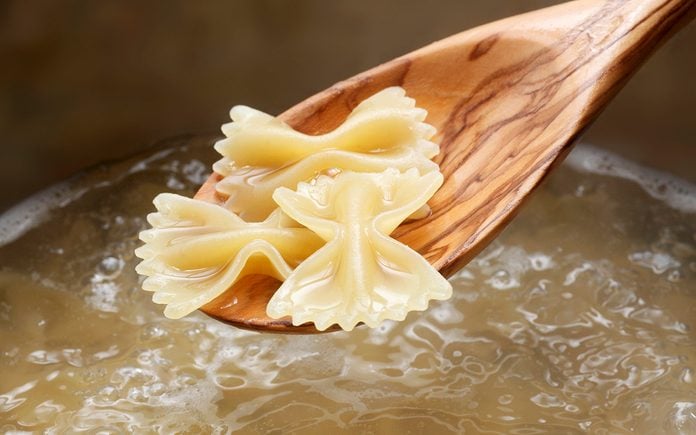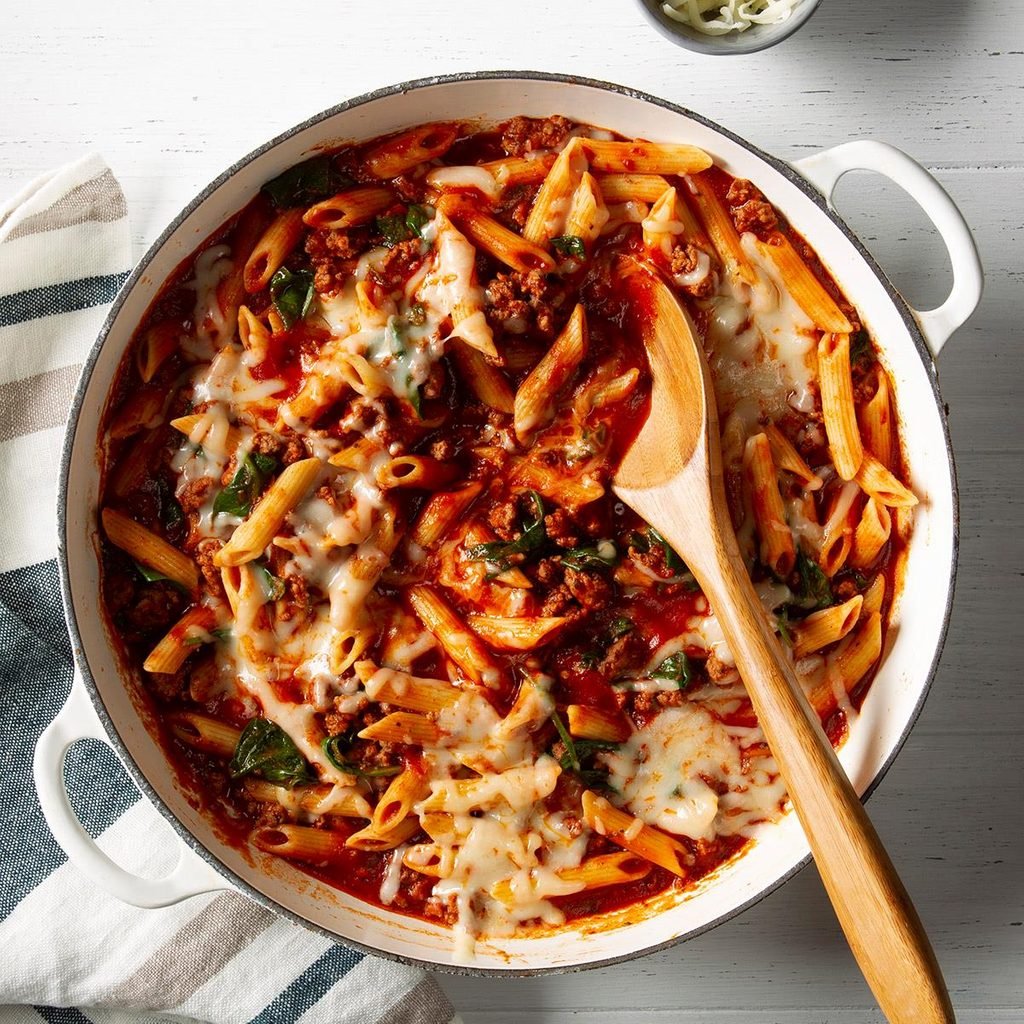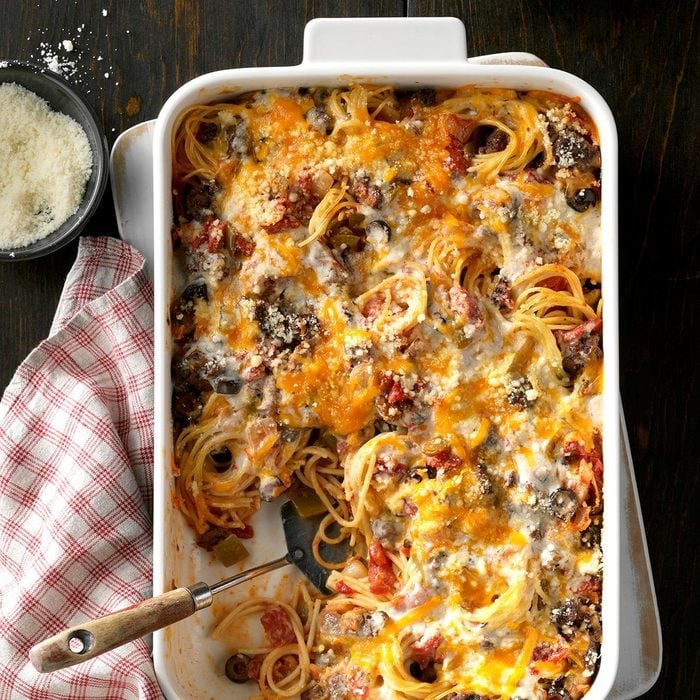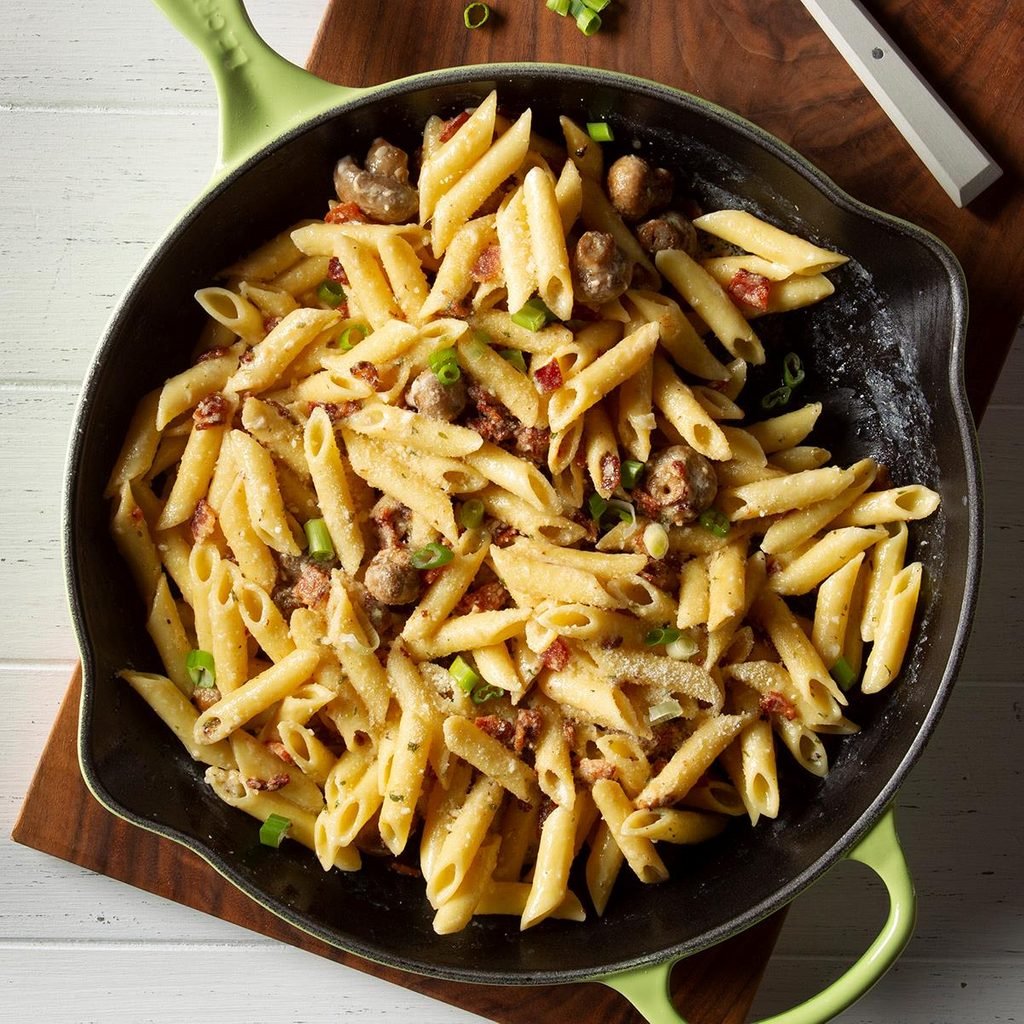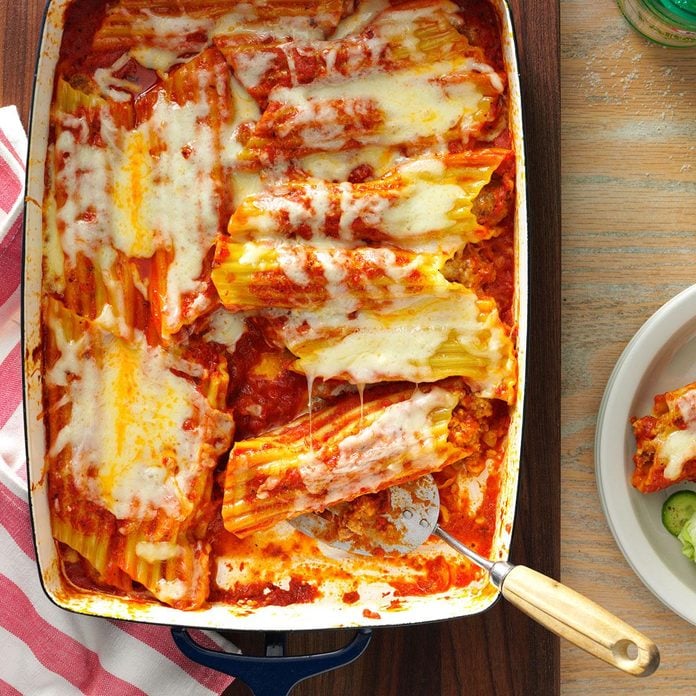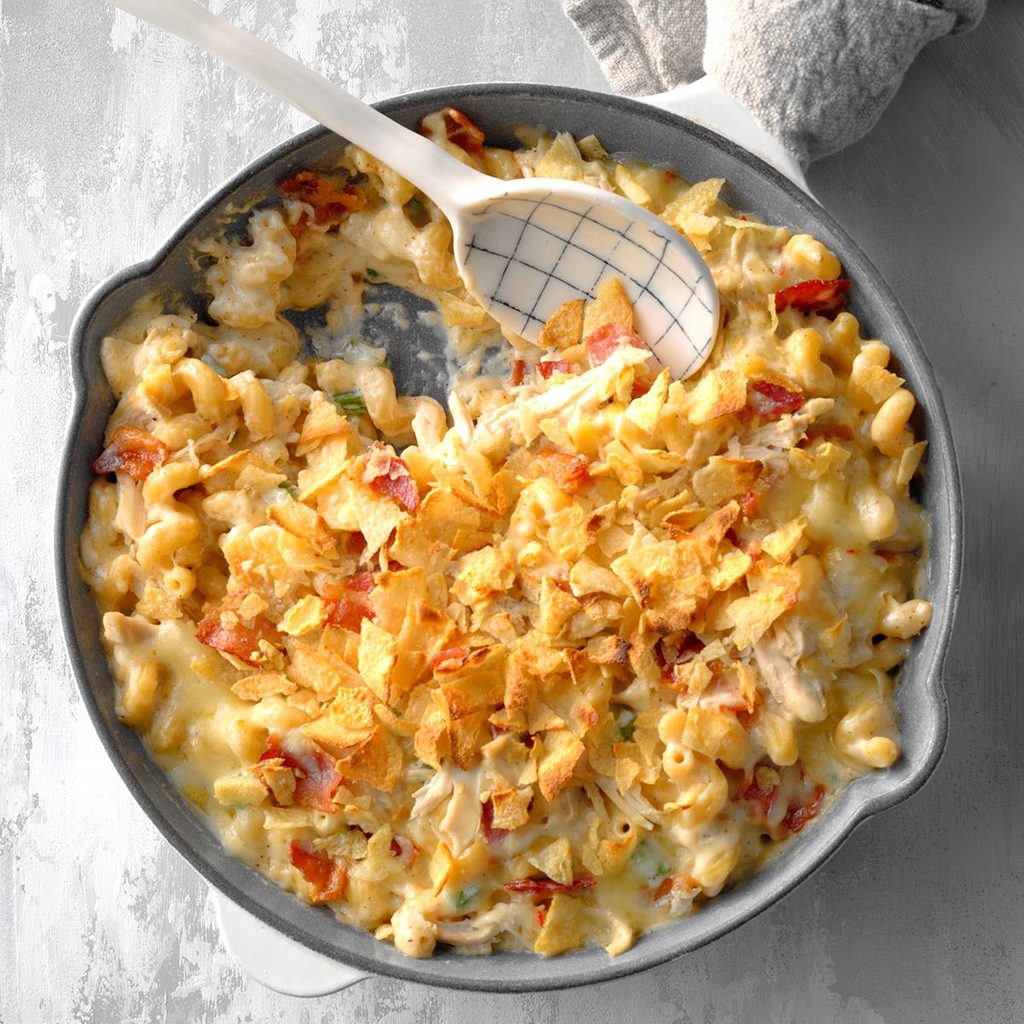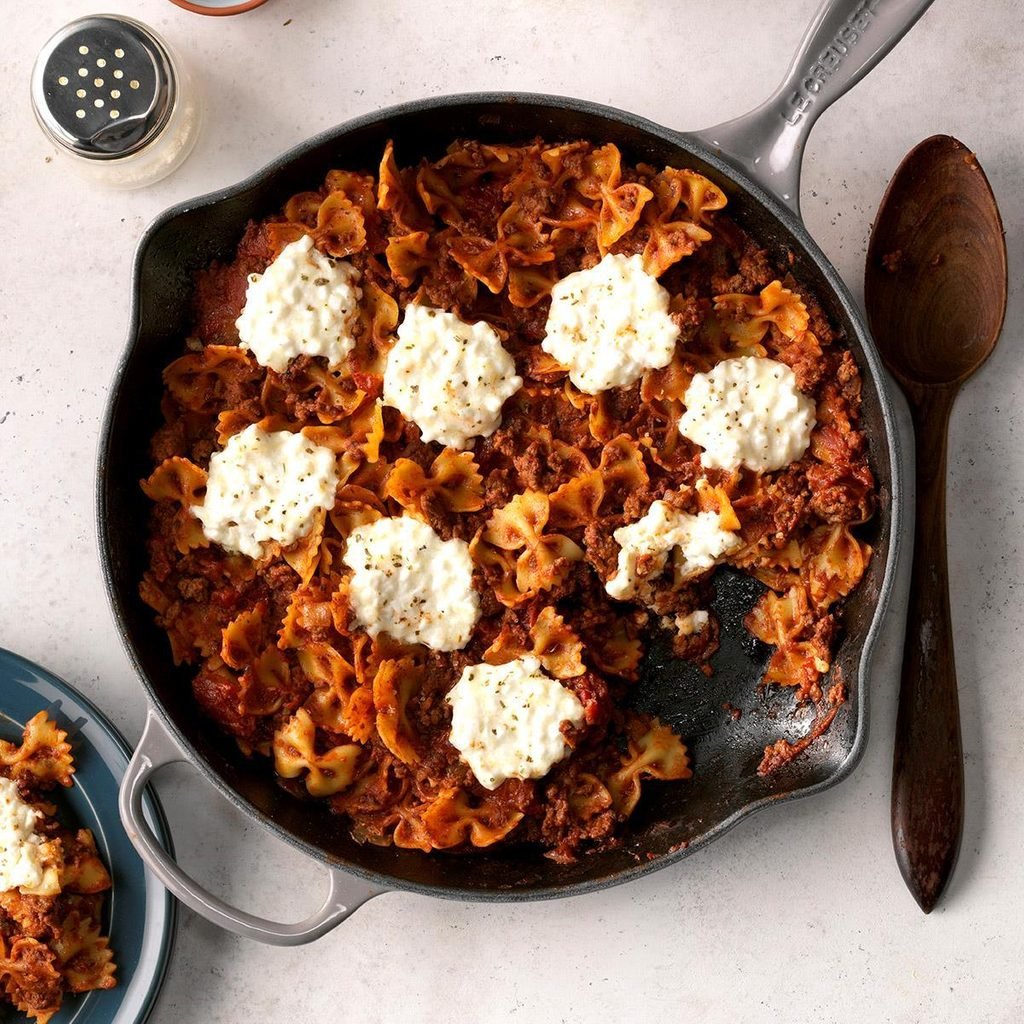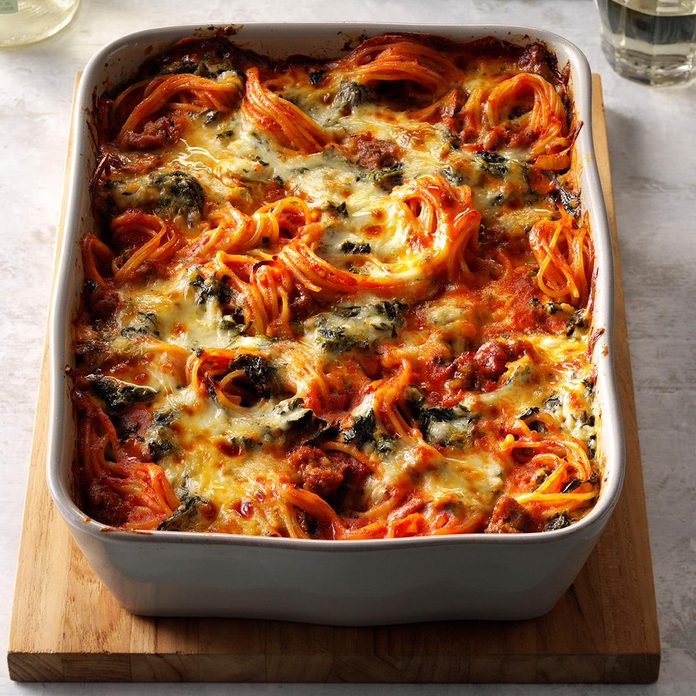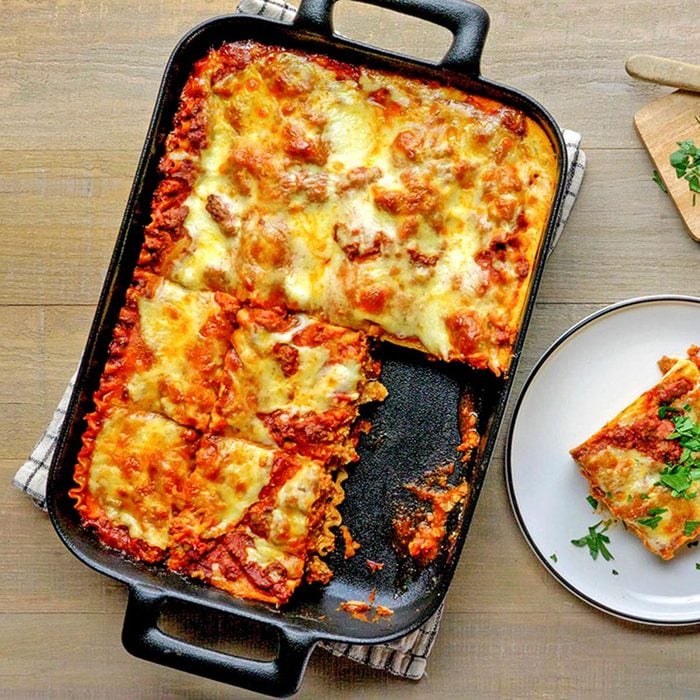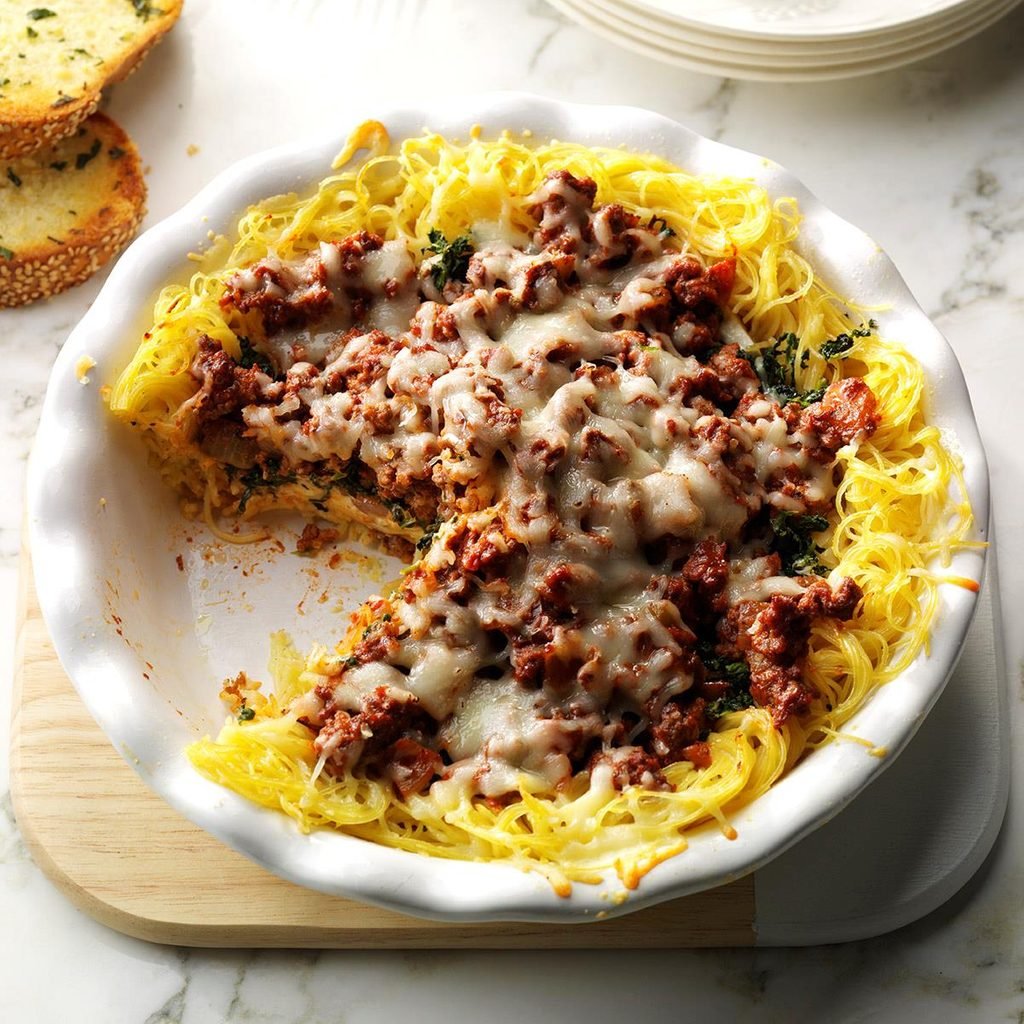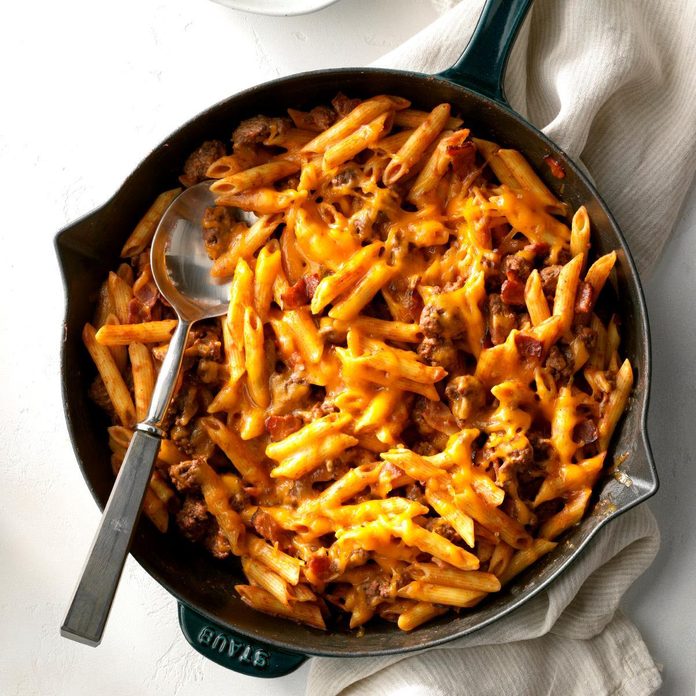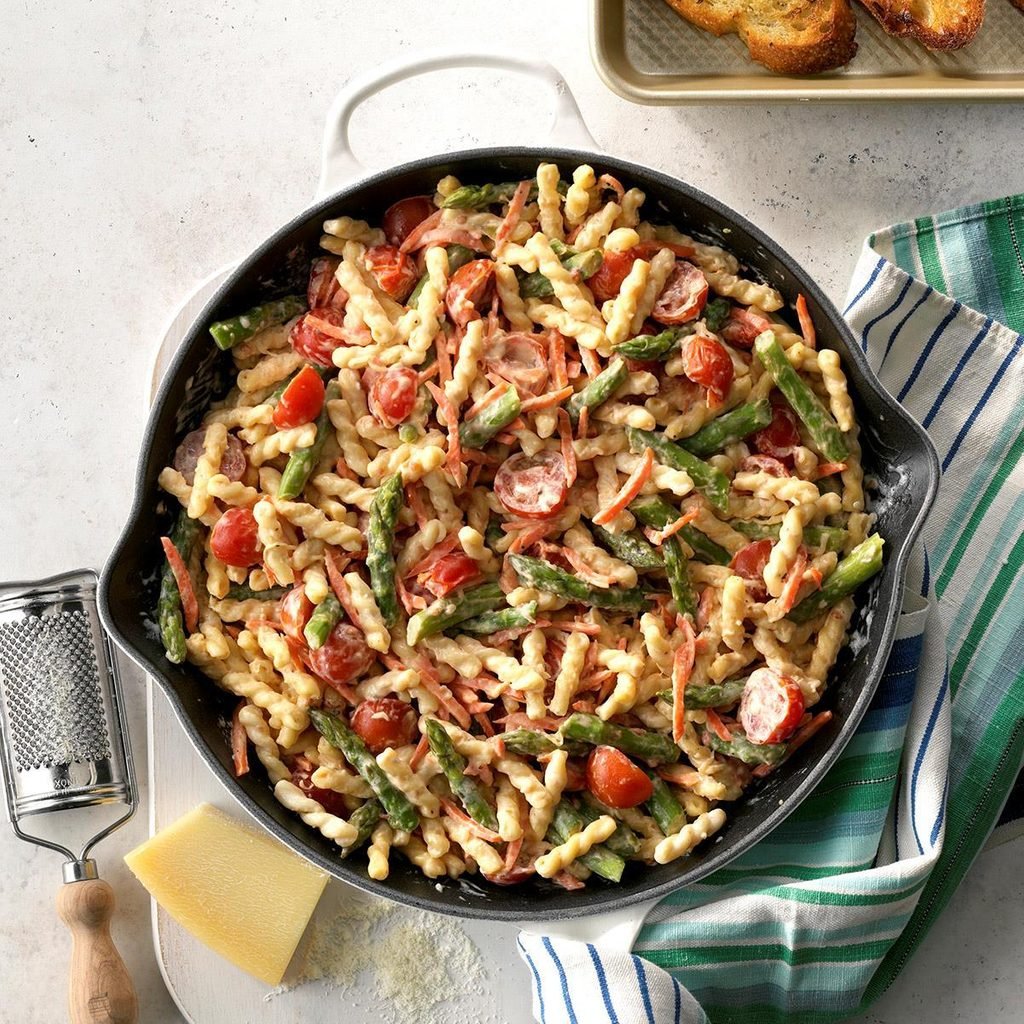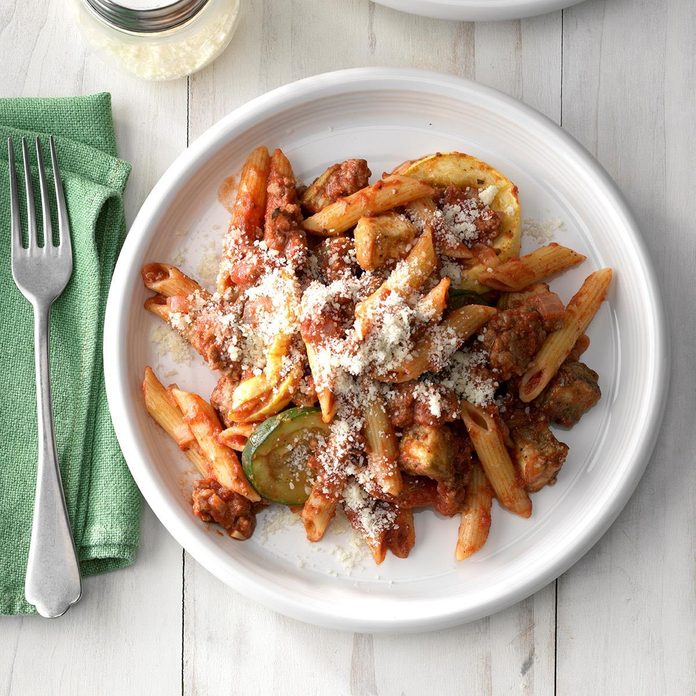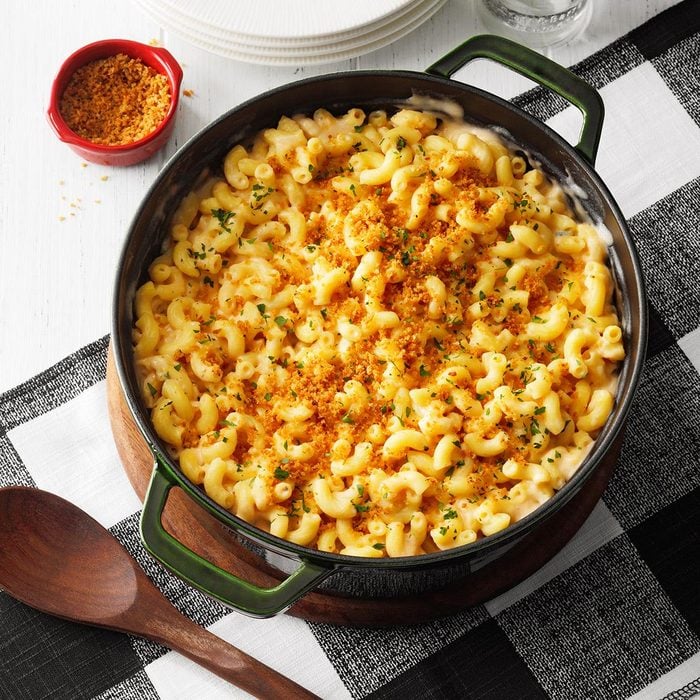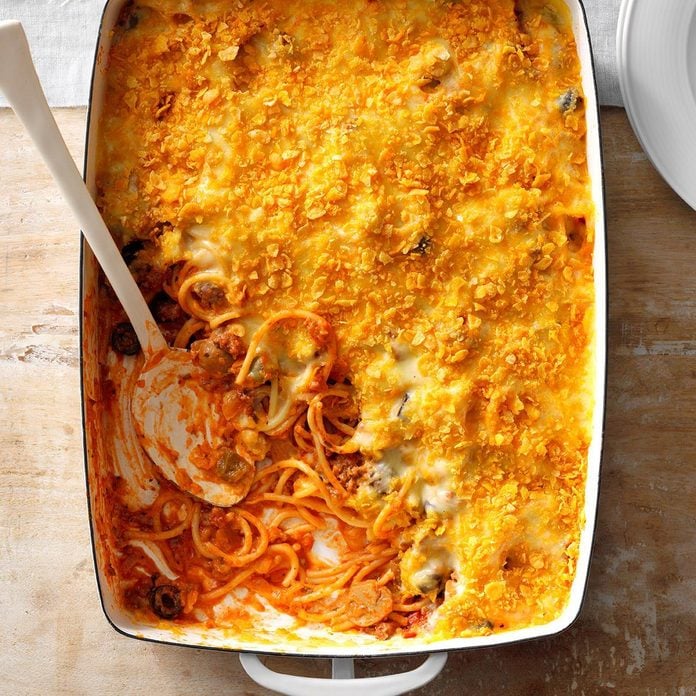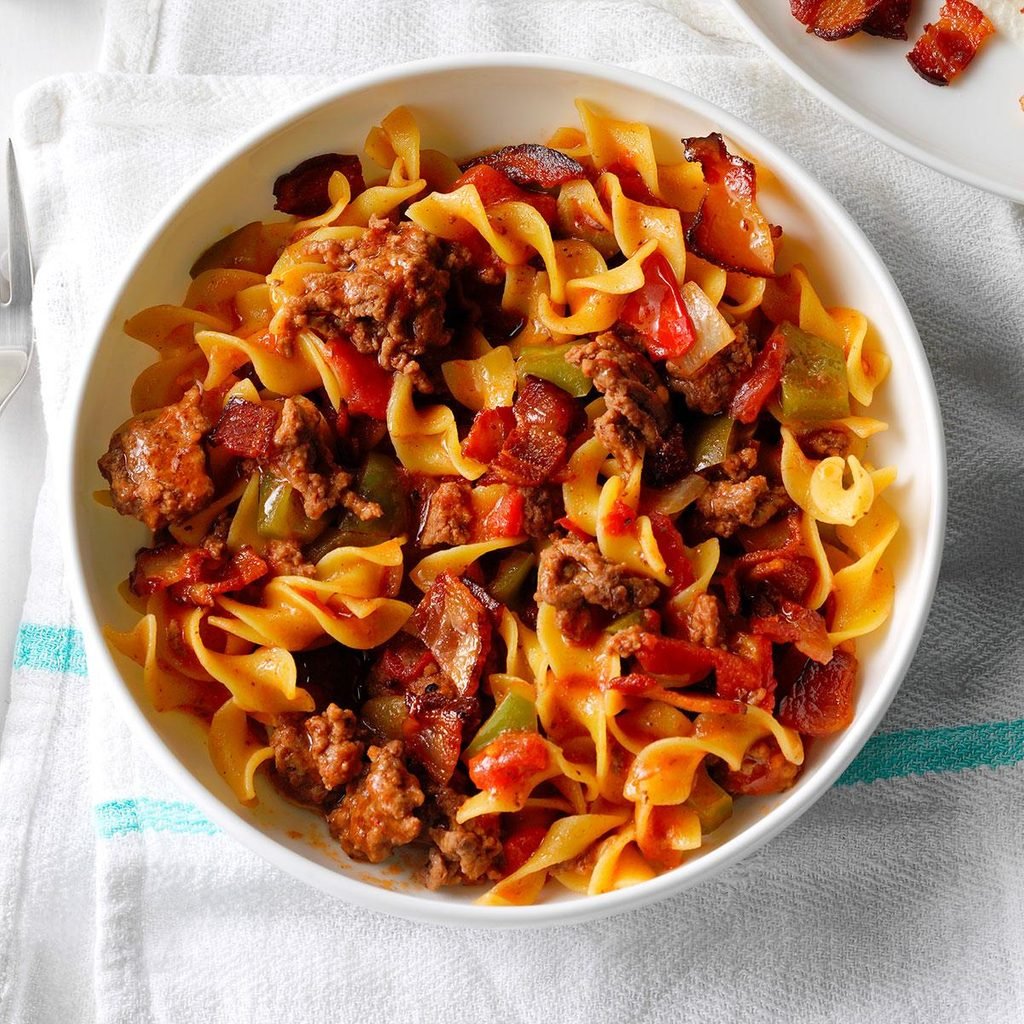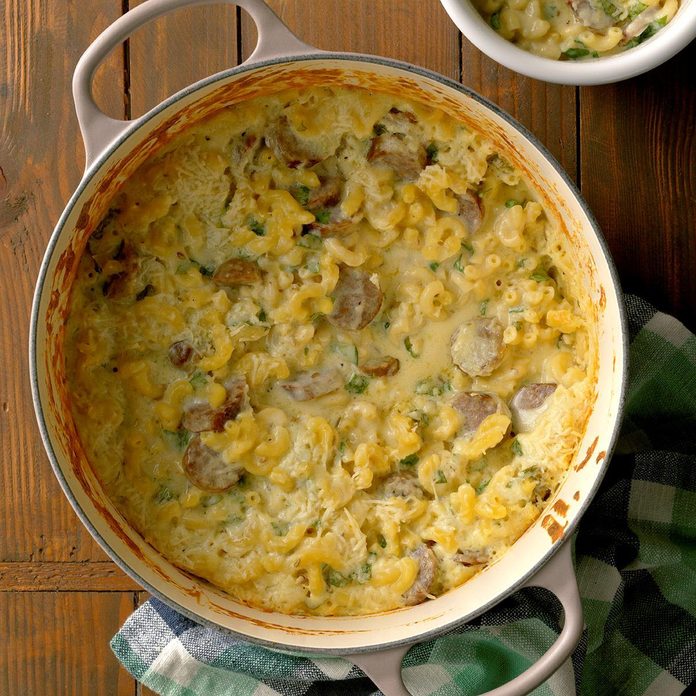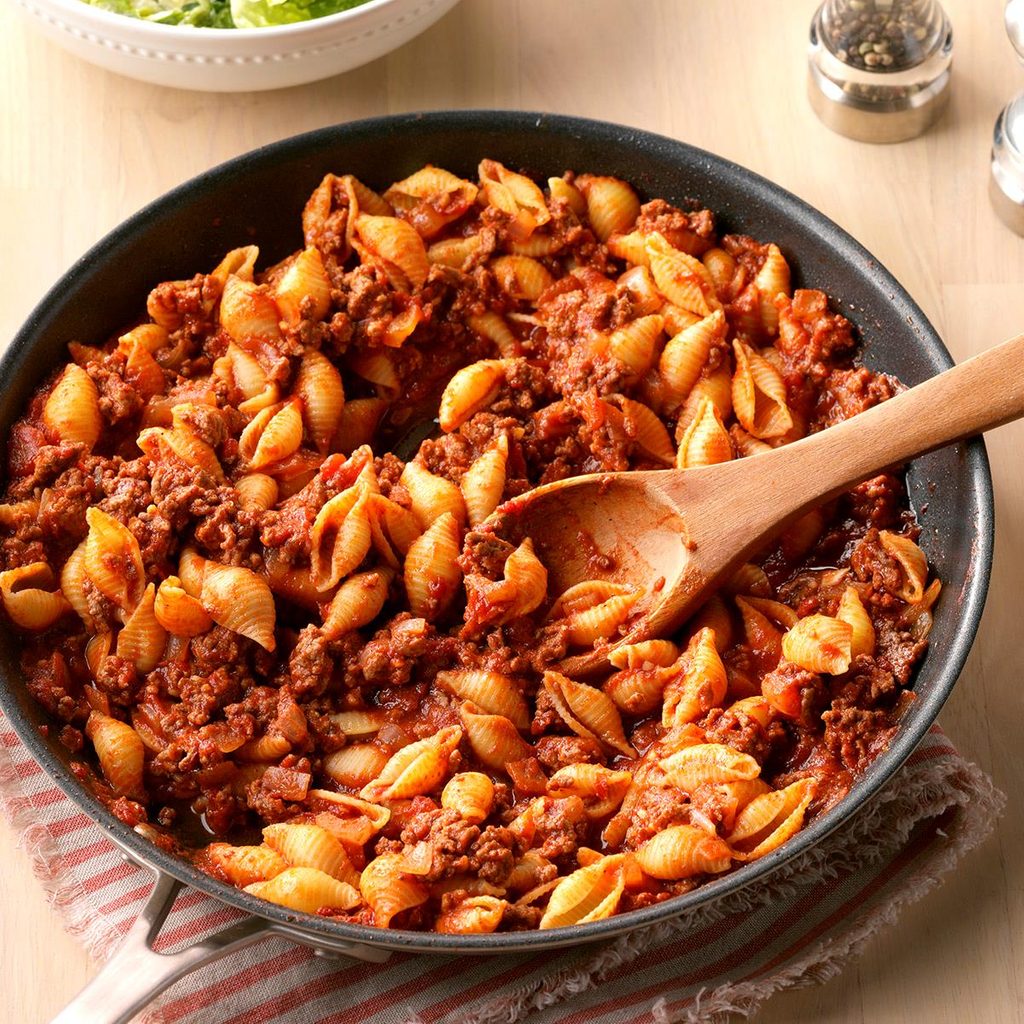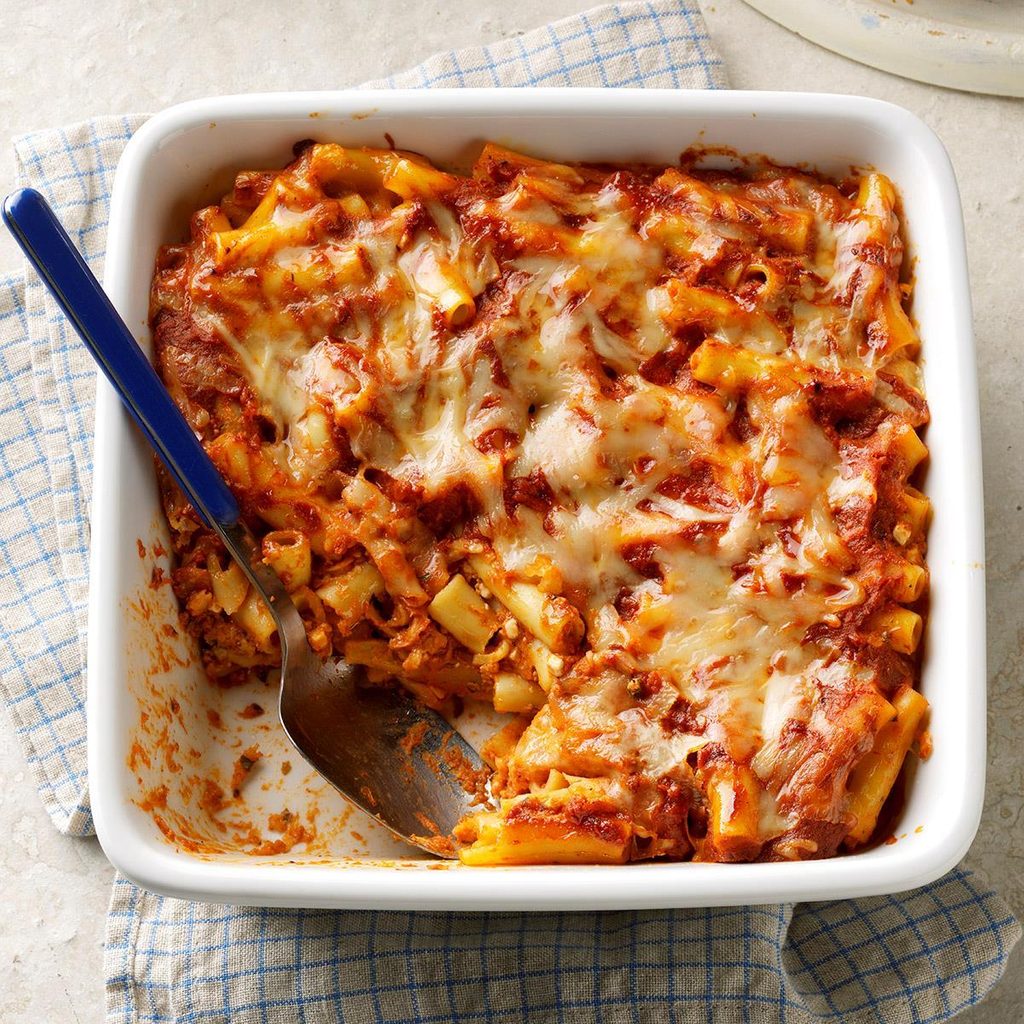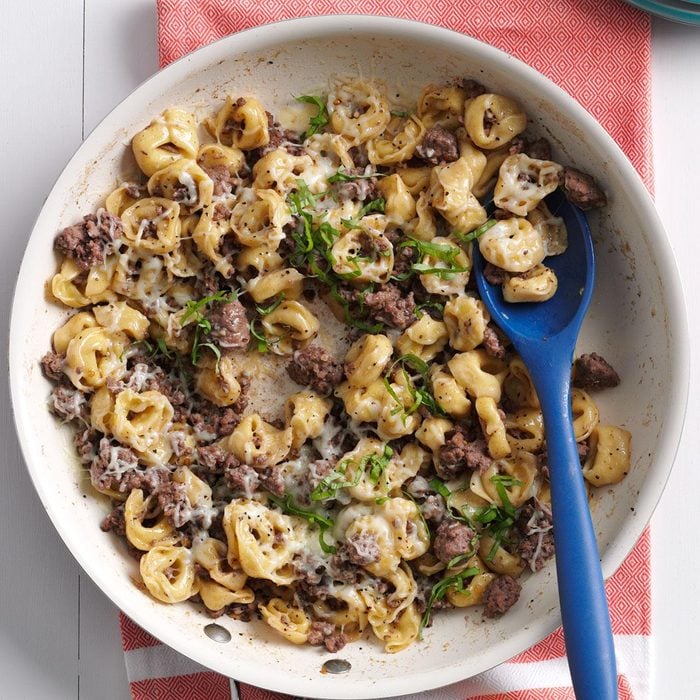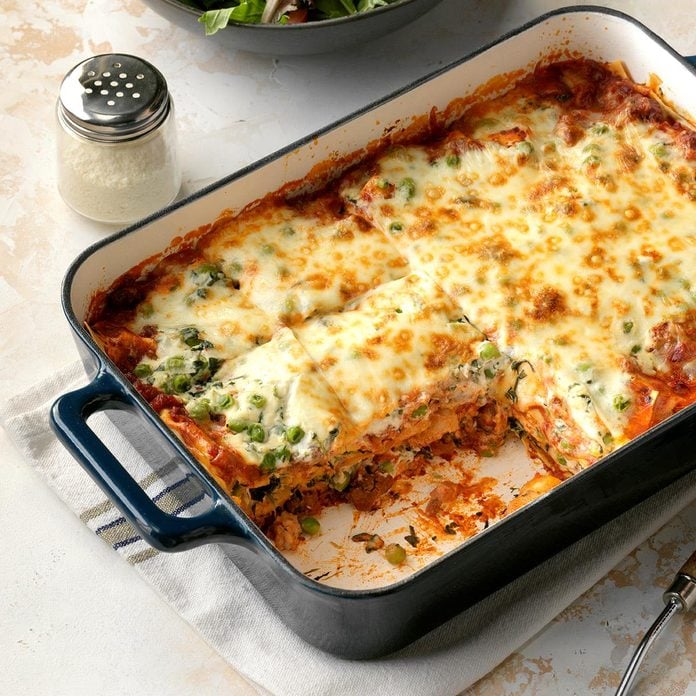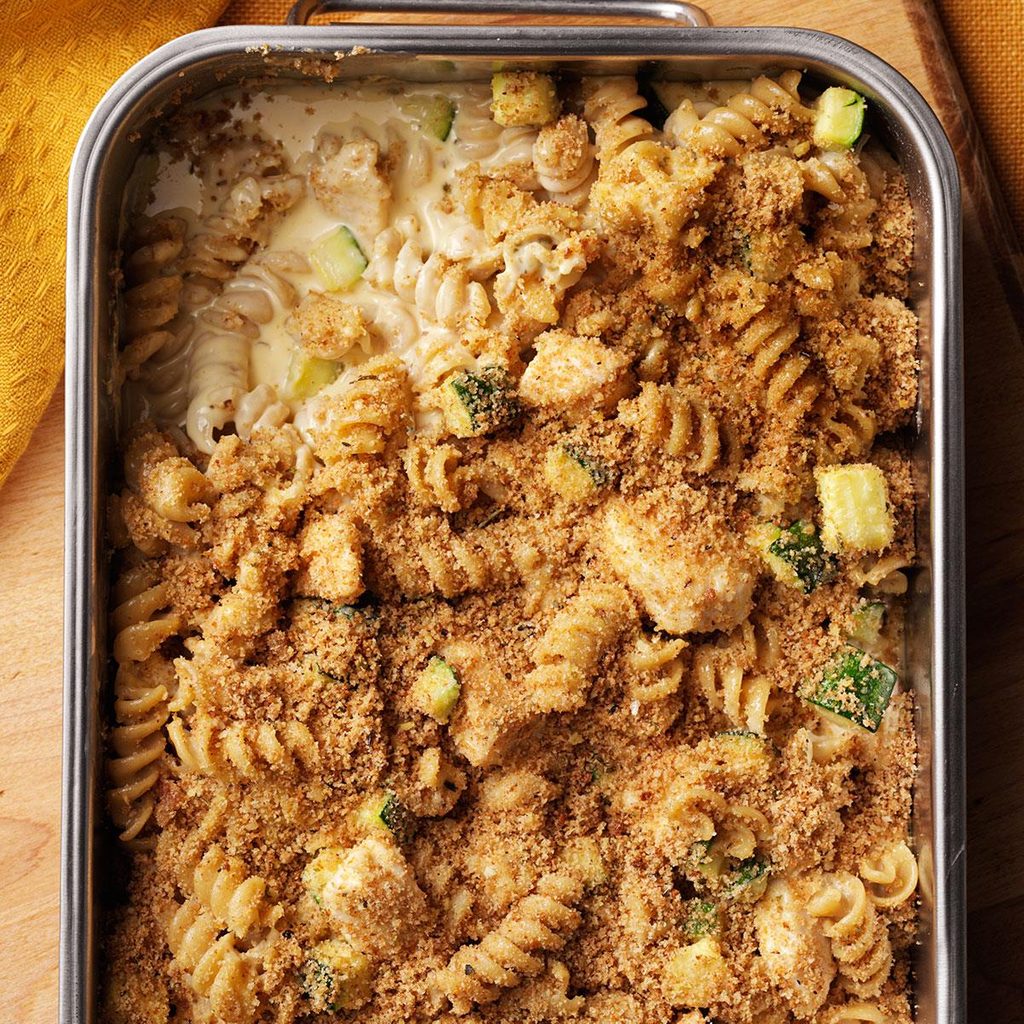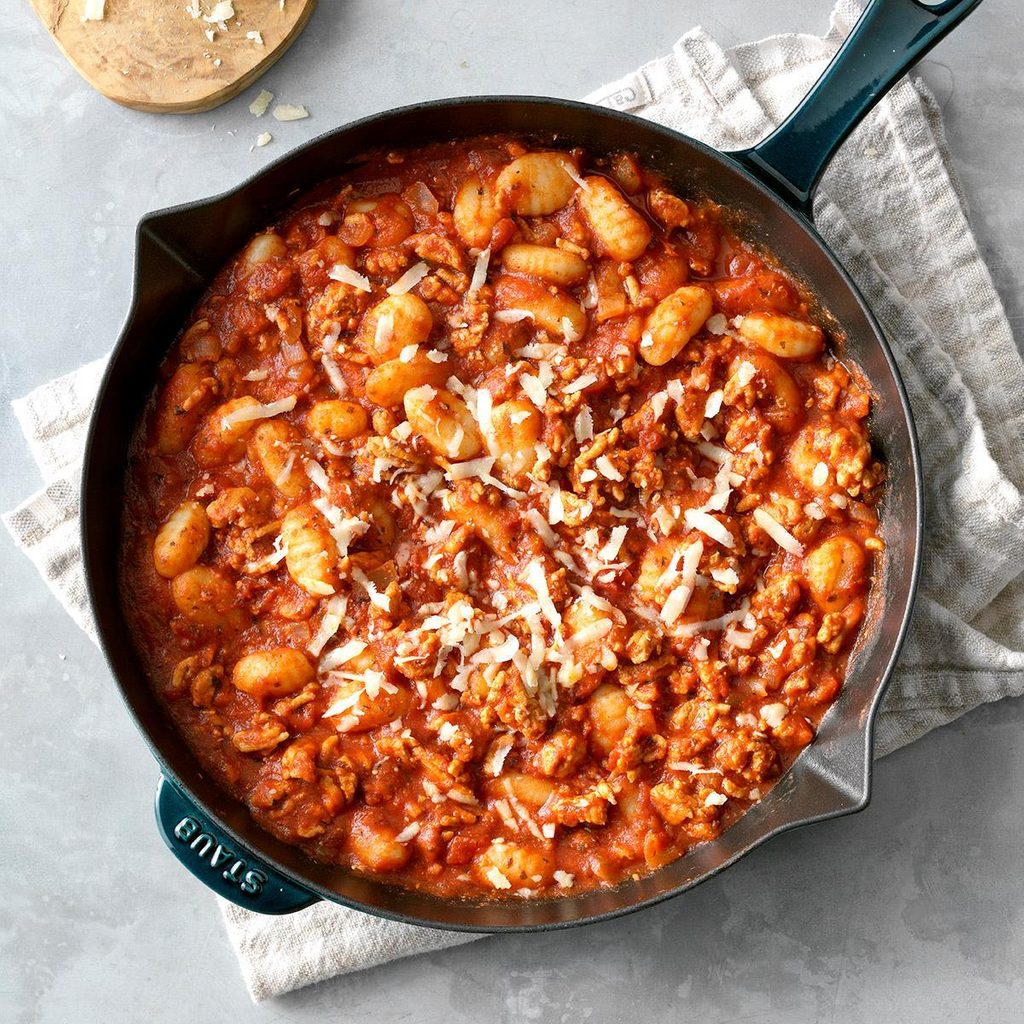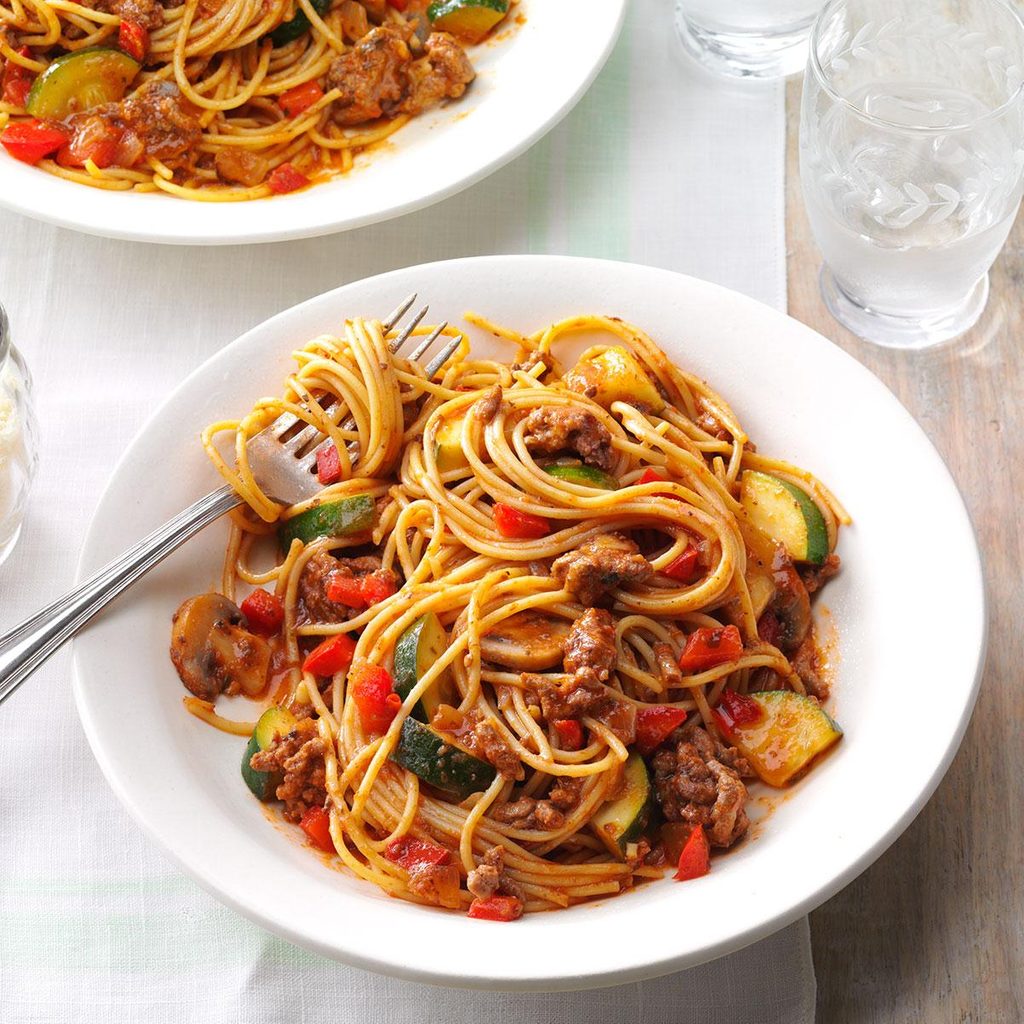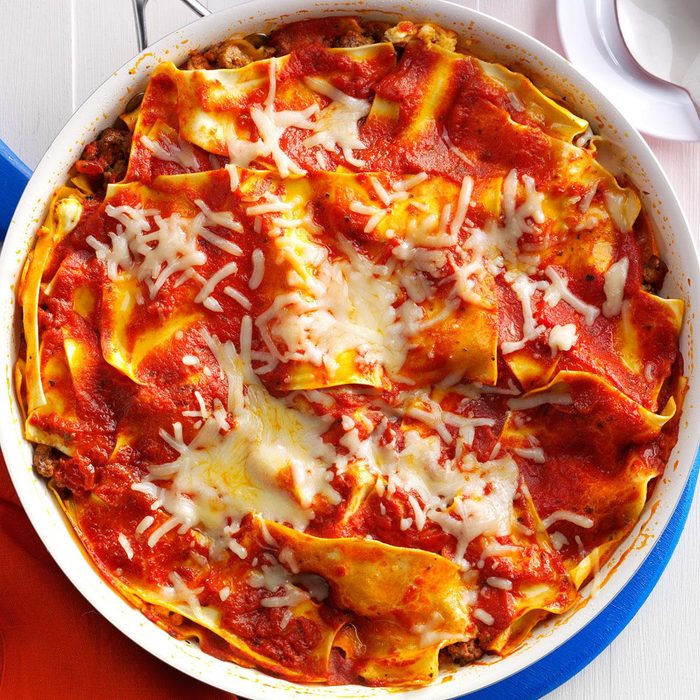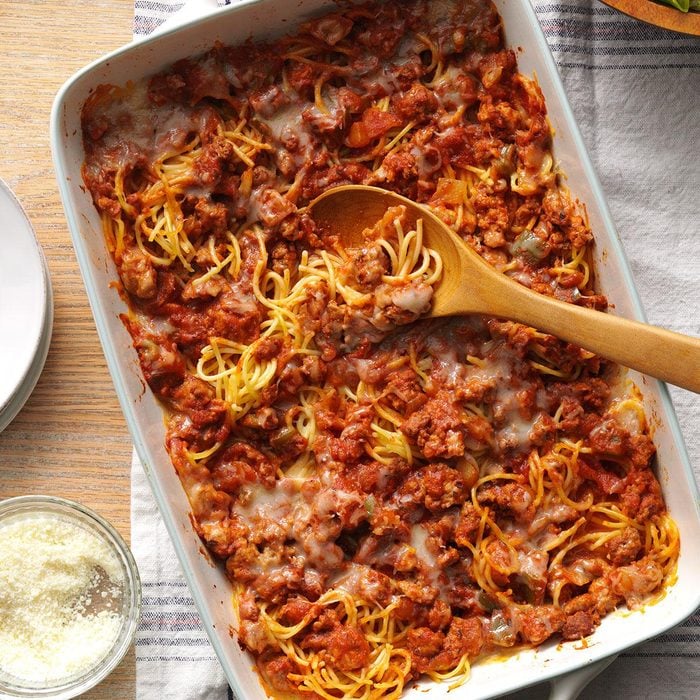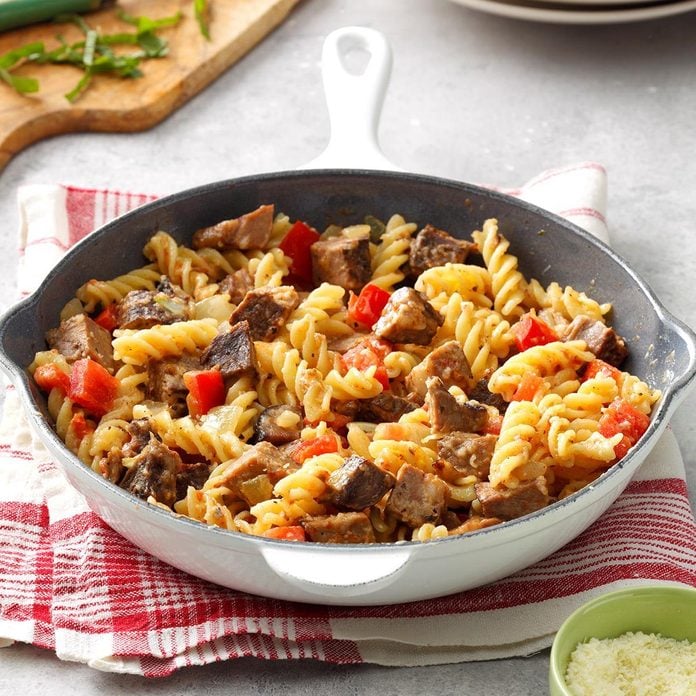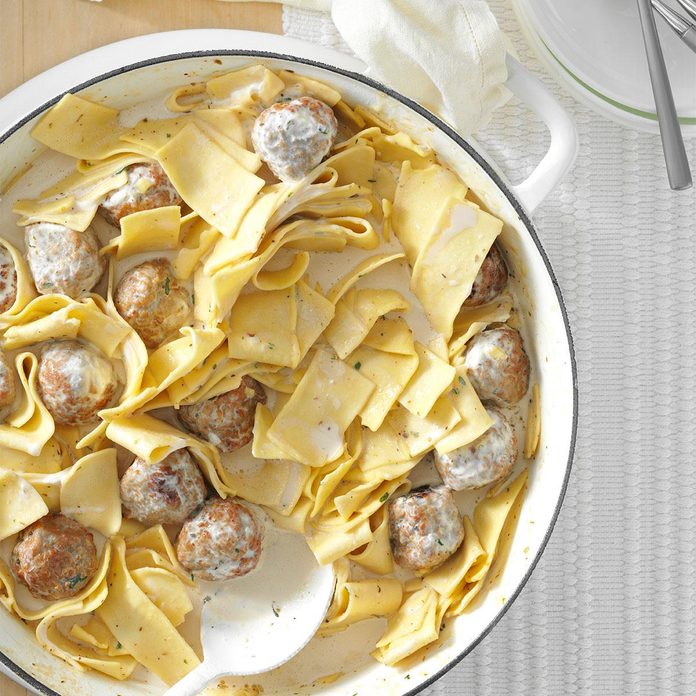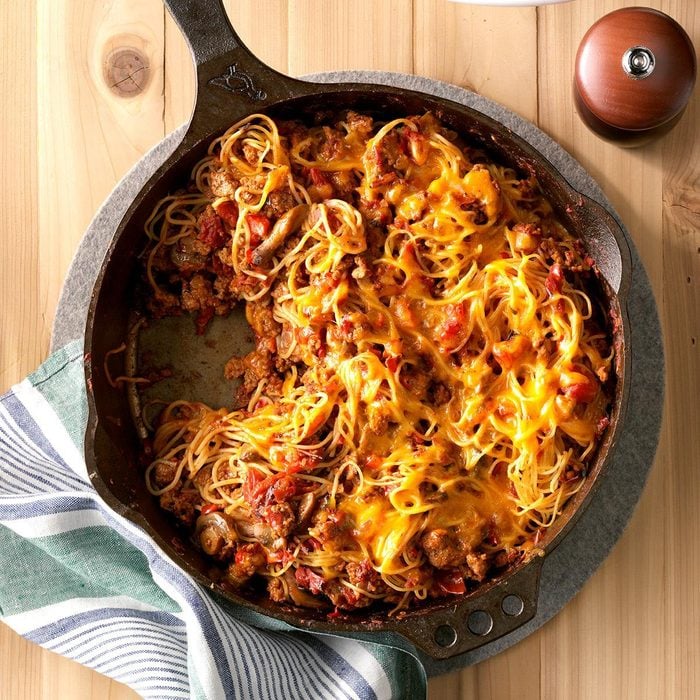Pasta is certainly a weeknight dinner hero. Quick pasta recipes are easy and inexpensive to throw together so dinner can be ready in a flash. While each pasta shape has a unique cooking time, just about every package instructs you to cook the noodles until they reach the “desired consistency.” For most, that’s al dente. But what is al dente, and how do you know when you’ve reached it?
What Is Al Dente?
The phrase al dente literally translates from Italian to mean “to the tooth.” It describes the texture of cooked pasta when it’s tender but firm and chewy when you bite into it. If your pasta is mushy and soft, you’ve blasted right past al dente and into well done. This softer pasta is easier to digest, but it contains fewer nutrients (more on that in a moment).
How Do You Know if Pasta Is Al Dente?
The best way to test if pasta is al dente is to take a bite. About two minutes before the time expires on the package directions, give the pasta a taste. If it’s tender enough to chew but still contains a bit of a bite, you’ve reached al dente. If it’s too firm for your liking, continue cooking it until it reaches the preferred level of doneness.
Can You Cook Fresh Pasta to Al Dente?
In case you were wondering, it’s not possible to achieve al dente status with fresh pasta or homemade pasta dough. These noodles cook in a matter of minutes—much more quickly than dried pasta—so they never reached that tender-firm stage. Instead, to check for doneness, bite into a noodle and look for a tiny white dot in the center. If you see it, continue cooking until it disappears.
Why Cook Pasta to Al Dente?
Why do recipes recommend cooking pasta until al dente? The answer is twofold: texture and nutrition. From a texture perspective, al dente pasta is firm and chewy, and it holds its shape whether it’s being tossed in sauce or baked in a casserole. It also contains more starches, which help the sauce cling to the pasta for a better eating experience.
Speaking of starches, al dente pasta is actually more nutrient-dense, too. The starch molecules aren’t fully released into the boiling water, allowing them to be slowly digested by your body. That means al dente pasta has a lower glycemic index than fully cooked pasta, which can prevent a spike in blood sugar.
Give your newfound knowledge a test-run with our best pasta recipes, ever.
Try These Comforting Pasta Recipes
Spaghetti Pie Casserole
My family adores this spaghetti casserole. It's old-timey comfort food. This is how to make baked spaghetti with cream cheese. —Patricia Lavell, Islamorada, Florida
Get Recipe
Hearty Penne BeefThis is comfort food at its finest! The best of everything is found here—it's tasty, easy and a smart way to sneak in some spinach for extra nutrition. —Taste of Home Test Kitchen
Butternut Squash Mac and CheeseI created this dish after my father had triple bypass surgery. He loves comfort food, and I wanted him to be able to enjoy a rich and tasty dish like mac & cheese without all the fat and butter. It's also a smart way to sneak in some veggies for children. —Megan Schwartz, New York, New York
Cheeseburger Stuffed Pasta ShellsYou could call this a comfort food mashup made in heaven. Jumbo stuffed pasta shells are loaded up with cheeseburger goodness in a dish that will soon become a family favorite. —Taste of Home Test Kitchen, Milwaukee, Wisconsin
Five-Cheese Ziti al FornoAfter having the five-cheese ziti at Olive Garden, I tried to make my own version of
al forno—and I think I got pretty close. I always double this when I'm making it and freeze the second one for another meal. —Keri Whitney, Castro Valley, California
Asparagus Tuna Noodle CasseroleI updated a traditional tuna casserole using fresh asparagus and asparagus soup. This is so different and so delicious. Use frozen asparagus when fresh is not in season. —Nancy Heishman, Las Vegas, Nevada
Sausage and Squash PenneI love using frozen cooked winter squash because the hard work—peeling, chopping and cooking—is all done for me. — Jennifer Roberts, South Burlington, Vermont
Creamy Salmon LinguinePesto grilled salmon gives this
creamy pasta toss a luxurious taste and texture. We love it as is, but you could easily sub in any veggies you have on hand for the broccoli. —Jacob Kitzman, Seattle, Washington
Homemade RavioliI love to bake and cook, especially Italian dishes like this homemade ravioli recipe. In fact, my idea of a perfect day consists of cooking my family's favorite foods then watching them dig in!—Lori Daniels, Hartland, Michigan
Baked SpaghettiEvery time that I make this cheesy baked spaghetti, I get requests for the recipe. It puts a different spin on pasta and is great for any meal. The leftovers, if there are any, also freeze well for a quick dinner later in the week. —Ruth Koberna, Brecksville, Ohio
Mushroom Pasta CarbonaraI absolutely love this creamy and cheesy mushroom carbonara. I serve it with a side salad and rolls to make a complete meal. —Cindi Bauer, Marshfield, Wisconsin
Sausage ManicottiThis classic Italian entree comes together in a snap but tastes as if it took hours. It's so tasty and easy to fix. My family always enjoys it. —Carolyn Henderson, Maple Plain, Minnesota
Spicy Chicken and Bacon MacI've been working to perfect a creamy, spicy mac and cheese for years. After adding smoky bacon, chicken, jalapenos and spicy cheese, this is the ultimate! I use rotisserie chicken and precooked bacon when I'm pressed for time. —Sarah Gilbert, Aloha, Oregon
Sausage & Swiss Chard LasagnaRustic and comforting, I found this rich and cheesy lasagna to be a great way to get kids to eat healthy greens—it's such a tasty casserole they'll never know the Swiss chard is there! —Candace Morehouse, Show Low, Arizona
Skillet Bow Tie LasagnaThis quick recipe tastes just like lasagna, but you make it on the stove. It's very tasty and is always a hit with my family. —Arleta Schurle, Clay Center, Kansas
Nutty Cheese TortelliniI like to plant Italian flat-leaf parsley in a long terra-cotta planter so I always have some on hand. It adds bright, fresh flavor to this pasta dish. —Barbara Penatzer, Vestal, New York
Florentine Spaghetti BakeThis hearty sausage entree will appeal to just about everyone. My daughter serves it often to her hardworking family on their wheat ranch in Montana. —Lorraine Martin, Lincoln, California
Chicken and Shrimp with Lemon Cream SauceMy kids love this creamy pasta. Whenever I make it, I know that they will happily clean their plates. —Joe Milholland, Smelterville, Idaho
Creamy Spinach & Rigatoni BakeMacaroni and cheese is one of the ultimate comfort foods. My recipe gives it an Italian twist. —Tammy Rex, New Tripoli, Pennsylvania
Tortellini CarbonaraBacon, cream and Parmesan cheese make a classic pasta sauce that's absolutely heavenly. It's a delightful option for company! —Cathy Croyle, Davidsville, Pennsylvania
Makeover Traditional LasagnaI’ve never been quick to pass along my special recipes, but this one is so good that it’s become our family’s Christmas Eve tradition! —Michelle Behan, Littleton, Colorado
Spinach-Beef Spaghetti PieWith its angel hair pasta crust, this cheesy ground beef, tomato and spinach pie is always a hit when I serve it. Each neat slice has layers of pasta, cream cheese filling and spinach topping. —Carol Hicks, Pensacola, Florida
Ham & Swiss Baked PenneAs a kid I loved to the hot ham and Swiss sandwiches from a local fast-food restaurant. With its melty, gooey goodness, this bake makes me think of them. —Ally Billhorn, Wilton, Iowa
Bacon Cheeseburger PastaI try to make foods that are not only kid friendly, but are also easy to reheat since my husband works long hours and often eats later than our children. If you like, use reduced-fat cheese and ground turkey for a lighter version. —Melissa Stevens, Elk River, Minnesota
Bow Ties with Gorgonzola SauceThe name may sound fancy, but this pasta dish is comforting and simple to prepare. Add a mixed green salad to make it a complete meal for any occasion. —Nadine Mesch, Mount Healthy, Ohio
Creamy Pasta PrimaveraThis pasta dish is a wonderful blend of crisp, colorful vegetables and a creamy Parmesan cheese sauce. —Darlene Brenden, Salem, Oregon
Easy Chicken TetrazziniThis easy chicken tetrazzini is made with leftover cooked chicken and canned soup. It's the perfect recipe for busy weeknights because it's so easy to assemble. Once you pop the dish in the oven, you'll have time to take care of other things on your to-do list. —Martha Sue Stroud, Clarksville, Texas
Eggplant Zucchini BologneseI roast the veggies while the pasta cooks, making this a quick dish. This meal-in-one blends rustic comfort with fresh flavors. —Trisha Kruse, Eagle, Idaho
Rigatoni with Sausage & PeasWith a tomato-y meat sauce and tangy goat cheese, this weeknight wonder is my version of comfort food. You want to have bowl after bowl. —Lizzie Munro, Brooklyn, New York
Tuna-Filled ShellsHot tuna's a hit when you mix it with sizable pasta shells and a cheesy sauce. Dill also complements the fish nicely in this cream comfort food. It's a great change of pace from the traditional tuna casserole. —Connie Staal, Greenbrier, Arkansas
Bistro Mac & CheeseI like to serve this mac & cheese with a salad and crusty bread. It's a satisfying meal that feels upscale, but will fit just about any budget. And because the Gorgonzola is so mild in this dish, even the kiddos will go for it. —Charlotte Giltner, Mesa, Arizona
Loaded Spaghetti BakeMake this loaded pasta recipe your own, everyone loves it! It's also great made with leftover chicken from the previous night's dinner. You might prefer another hard cheese for the Parmesan…or just go with the cheddar and cornflake crumbs. —Marian Pappas, Lake Stevens, Washington
Spanish Noodles & Ground BeefBacon adds crunch to this comforting stovetop supper my mom used to make when I was a kid. Now I prepare it for my own family. —Kelli Jones, Perris, California
Gnocchi AlfredoThis gnocchi is one of my go-to's for company and potlucks. It’s pure comfort food, especially in the wintertime. —Jessica Silva, East Berlin, Connecticut
Pizza Macaroni BakeWhat do you get when you combine macaroni and cheese with pizza fixings? This hearty, family-pleasing casserole! It's so easy and so tasty. —Nancy Porterfield, Gap Mills, West Virginia
Pressure-Cooker Cajun Chicken AlfredoThis recipe is a true comfort food! Cajun spice adds a nice heat to the creamy Alfredo sauce. Add more or less seasoning depending on your preferred spice level. And nothing beats having to clean only one pot. The dish would also be tasty with shrimp or smoked sausage. —Jennifer Stowell, Deep River, Iowa
Beefy Noodle CasseroleWhen life calls for a dish for a potluck or family event, we stir up a batch of beef and noodles. That’s our cheesy, bubbly comfort food. —Susan Lavery, McKinney, TX
Sicilian Mac & CheeseTo give our mac and cheese a Sicilian touch, we mix sausage, basil and fennel with three cheeses for an incredibly comforting casserole. —Michael Cohen, Los Angeles, California
Artichoke Blue Cheese FettuccineStore-bought Alfredo sauce speeds along this flavorful, meatless entree. I use dry pasta, but you can use refrigerated fettuccine to make this recipe even faster. —Jolanthe Erb, Harrisonburg, Virginia
Stovetop Beef and ShellsI fix this supper when I'm pressed for time. It's as tasty as it is fast. Team it with salad, bread and fruit for a comforting meal. —Donna Roberts, Manhattan, Kansas
Ziti BakeMy children have frowned upon many of my casserole recipes, but they give a cheer when they hear we're having baked ziti for supper. I've tried to incorporate more meatless meals into our menus, which is how this recipe got started. No one misses the meat. They even like the leftovers! —Charity Burkholder, Pittsboro, Indiana
Beefy Tortellini SkilletThis tortellini dish is a one-skillet-wonder the family craves. From browning beef to cooking the pasta and melting the cheese, everything happens in one pan. You can add basil or chives for a touch of freshness. —Juli Meyers, Hinesville, Georgia
Southwest Tuna Noodle BakeNone of my co-workers had ever tried tuna noodle casserole, and since we live near the Mexican border, they challenged me to make a Southwest version. After trying the tasty results, everyone wanted the recipe! —Sandra Crane, Las Cruces, New Mexico
Copycat Pasta Da VinciI fell in love with this dish at the restaurant and experimented until I could duplicate it at home. What's so nice is that the sauce can be made ahead and be refrigerated or frozen. Now you can have a delicious copycat Cheesecake Factory pasta da Vinci on a weeknight. —Trisha Kruse, Eagle, Idaho
Creamy Chicken FettuccineConvenient canned soup and process American cheese hurry along the assembly of this creamy sauce loaded with delicious chunks of chicken. —Melissa Cowser, Greenville, Texas
Argentine LasagnaMy family is from Argentina, which has a strong Italian heritage and large cattle ranches. One of our favorite Argentinian recipes is this all-in-one lasagna packed with meat, cheese and veggies. —Sylvia Maenenr, Omaha, Nebraska
Whole Wheat Pasta BakeWith a casserole this rich and saucy, it’s tempting to skip the crunchy topping and dip a fork straight into the skillet. But the bread crumbs on top make this one extra special. —Taste of Home Test Kitchen, Milwaukee, Wisconsin
Gnocchi Chicken SkilletStovetop chicken and gnocchi recipes like this one make for a homey dinner in a hurry. Personalize it with your own favorite sauce and seasonings. —Taste of Home Test Kitchen, Milwaukee, Wisconsin
Hearty Garden SpaghettiMy husband and I wanted a pleasing dish that didn’t leave a ton of leftovers. My spaghetti with beef and fresh veggies is perfectly filling for four. —Wanda Quist, Loveland, Colorado
Prepared sauce accents this warm chicken pesto pasta. Keep pesto in the freezer for the next time you have leftover chicken. —Taste of Home Test Kitchen, Milwaukee, Wisconsin
Springtime PenneWith ham, asparagus, onion and pasta in a creamy sauce, this stovetop supper is tasty enough for even your pickiest guests. It's great with penne, but you can also try it with mostaccioli or another type of pasta. —Cheryl Newendorp, Pella, Iowa
Saucy Skillet LasagnaThanks to no-cook noodles, this skillet lasagna makes a fresh, filling, flavorful and fast entree for any Italian meal. —Meghan Crihfield, Ripley, West Virginia
Pesto GnocchiPerk up gnocchi and vegetables with a flavorful pesto sauce. If you don't have pine nuts for the topping, skip or substitute any nut you like. —Taste of Home Test Kitchen, Milwaukee, Wisconsin
Rich Baked SpaghettiIt takes a little longer to make baked spaghetti, but the difference in taste, texture and richness is well worth the time. I serve this lasagna-style dish with a tossed green salad and breadsticks for a hearty, healthy meal. —Betty Rabe, Mahtomedi, Minnesota
Artichoke Florentine PastaPasta loaded with artichokes and creamy cheese is everything a Sunday dinner should be: rich, tasty and memorable. Add cooked chicken, shrimp or crab if you like. —Nancy Beckman, Helena, Montana
Baked Pumpkin Goat Cheese Alfredo with BaconThis is a unique and delicious pasta, perfect for fall. I made this for my girlfriends, and everyone asked for the recipe! —Ashley Lecker, Green Bay, Wisconsin
Spicy Shrimp & Penne PastaI created this creamy pasta dish when I needed to use up some marinara. Red pepper flakes give it a little heat, which my family loves. It's super versatile, so try it with chicken, or simply stir in some fresh basil, too. —Lorri Stout, Gaithersburg, Maryland
Creamy Prosciutto PastaI'm always looking for dinners that I can put together quickly. I re-created a favorite pasta dish from an Italian restaurant by using grocery store convenience products. Add crusty bread and a salad for a complete meal. —Christine Ward, Austin, Texas
Roast Beef Pasta SkilletLeftover beef is the star in a skillet dinner that's perfect for two. Chopped tomatoes and Parmesan cheese add color and flavor to this no-fuss dish. —Bill Hilbrich, St. Cloud, Minnesota
Turkey Mushroom TetrazziniYour family will flip over this turkey and mushroom casserole. In fact, the creamy Parmesan-topped tetrazzini is so satisfying, no one will suspect it's lower in fat! —Irene Banegas, Las Cruces, New Mexico
Four-Cheese Sausage RigatoniTo make this twist on traditional baked pasta, we start with creamy goat cheese and build from there with mozzarella, ricotta and Parmesan cheese. —Teresa Ralston, New Albany, Ohio
Easy Meatball StroganoffThis recipe has fed not only my own family, but many neighborhood kids! They come running when I make this supper. It's one of those things you throw together after work on a busy day because you know it works. —Julie May, Hattiesburg, Mississippi
Penne Beef BakeI had ground beef and veggies on hand so I came up with this pizza-flavored casserole. I never expected my family to love it so much. It's a good way to sneak in some extra veggies for the kids. —Jennifer Wise, Selinsgrove, Pennsylvania
Italian Sausage with Bow TiesWe often have our favorite pasta when company comes over, and I’ve shared this Italian sausage recipe several times. Now many of my friends make it for their families, too. —Janelle Moore, Auburn, Washington
Mom's Macaroni and CheeseThe wonderful homemade goodness of this creamy Velveeta mac and cheese makes it a staple side dish in my mother's kitchen and in mine as well. It has tender noodles and a crowd-pleasing golden crumb topping. —Maria Costello, Monroe, North Carolina
One-Skillet PastaThis recipe was given to me 25 years ago and remains a family favorite. It's a tasty twist on traditional spaghetti, and making a one-skillet pasta saves time on prep and cleanup, too. —Susan Spence, Lawrenceville, Virginia
Chicken Cordon Bleu PastaFacebook fans of my blog, Chef in Training, inspired me to make this creamy pasta casserole out of ingredients I had on hand. Success! I took the dish for another flavorful spin and added a bit of smoky bacon and toasted bread crumbs. —Nikki Barton, Providence, Utah
Pasta with Creamy Fennel SauceWhen pureeing fennel one day, I realized its velvety texture would make for a creamy, delicious pasta sauce—without all the guilt. My experiment worked, and now I enjoy this good-for-you pasta sauce all the time. —Deb Schwab, Moraga, California
Italian Pasta BakeI love to make this pasta bake whenever I need to bring a dish to pass. Fresh tomatoes add a nice touch that's missing from most other meat, pasta and tomato casseroles.—Karla Johnson, East Helena, Montana
Veggie LasagnaNo one will even miss the meat when you serve this vegetable-rich lasagna. It has a fresh, full-bodied flavor. To save time, prepare the carrot and spinach layers in advance. —Mary Jane Jones, Williamstown, West Virginia
Broccoli Mac & Cheese BakeMy husband made a version of this casserole for me on our first date. Over the 11 years we’ve been married, we’ve made
several changes to the
ingredients and now it’s even better than the original. —Lisa DeMarsh, Mount Solon, Virginia
Cajun Chicken & PastaThis kicked-up pasta dish is a family favorite and my most-requested recipe. It's easy to adapt too. Substitute shrimp for the chicken, add your favorite veggies and adjust the spice level to your family's taste—you can't go wrong! —Dolly Kragel, Sloan, Iowa
Looking for the
best pasta recipes? Look no further these incredible 5-star dishes.
